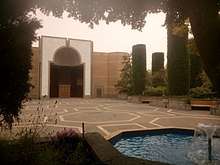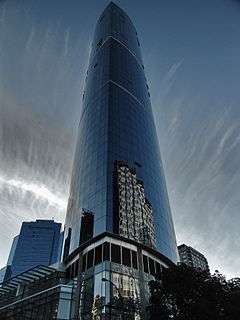Bruno Freschi
Bruno Freschi (born: 1937) is a Canadian architect and Officer, Order of Canada, best known for his role as chief architect for Expo 86 in Vancouver, British Columbia, Canada. Some of his notable works include the Science World, Vancouver, The Ismaili Centre, Burnaby, and the Staples Residence in Vancouver.[1][2]
Bruno Freschi | |
|---|---|
| Born | April 18, 1937 Trail, British Columbia, Canada |
| Nationality | Canadian |
| Alma mater | University of British Columbia |
| Occupation | Architect |
| Awards | Officer of the Order of Canada |
| Practice | Bruno Freschi Architects |
| Projects | Expo 86 |
Biography
Freschi was born in Trail, British Columbia on April 18, 1937. He studied architecture at the University of British Columbia where he received Canada's top architecture student award . He then studied in London at the Architectural Association before returning to Vancouver, British Columbia, Canada to work with Arthur Erickson in the 1960s. He founded his own firm, Bruno Freschi Architects, in 1970 in Vancouver. He was dean of the school of architecture and planning at the State University of New York at Buffalo, NY, USA until 2002.[3][4][5]
Works
1966 - Designs the Staples Residence in West Vancouver, an icon of west coast modern architecture.
1985 - Completes the architecture, design, and construction of the Vancouver Ismaili Centre for His Highness the Aga Khan.
1986 - Master Planner & Chief Architect, Expo 86.

 Science World at Telus World of Science, Vancouver, British Columbia
Science World at Telus World of Science, Vancouver, British Columbia

.jpg)
Freschi's work explores mediums as a form of expressionism. He also explores themes for politics and urbanization through painting and sculpture. His exhibition, 'Body Politick: The Art & Architecture of Bruno Freschi' opened on June 28, 2018, at Il Museo inside the Italian Cultural Centre in Vancouver.[8]
Awards
In 1985, Bruno Freschi was awarded the Officer, Order of Canada for Architecture (O.C.).[9][10]
References
- "Architect Bruno Freschi set to show the drawings and paintings that have driven his work | Georgia Straight Vancouver's News & Entertainment Weekly". The Georgia Straight. 2015-06-01. Retrieved 2020-08-03.
- "CBC - Expo 86 - Looking Back at the Architectural Legacy". CBC. Retrieved 2020-08-03.
- Herko, Carl,. "Bruno Freschi - An architect's grand design on the future". The Buffalo News. Retrieved 2020-08-03.CS1 maint: extra punctuation (link)
- "Twenty-five years later, architect recalls the development of the Ismaili Centre, Burnaby". the.Ismaili. 2010-11-05. Retrieved 2020-08-03.
- "Bruno Freschi". Archnet. Retrieved 2020-08-03.
- "Bruno Freschi | Companies | EMPORIS". www.emporis.com. Retrieved 2020-08-03.
- "Bruno Freschi | Companies | EMPORIS". www.emporis.com. Retrieved 2020-08-03.
- "The Body Politick: The Art & Architecture of Bruno Freschi | sala.ubc.ca". sala.ubc.ca. Retrieved 2020-08-03.
- "The Governor General of Canada - Order of Canada - Bruno B. Freschi". The Governor General of Canada. Retrieved 2020-08-03.
- "Order of Canada - Royal Architectural Institute of Canada". raic.org. Retrieved 2020-08-03.
| Wikimedia Commons has media related to Bruno Freschi. |